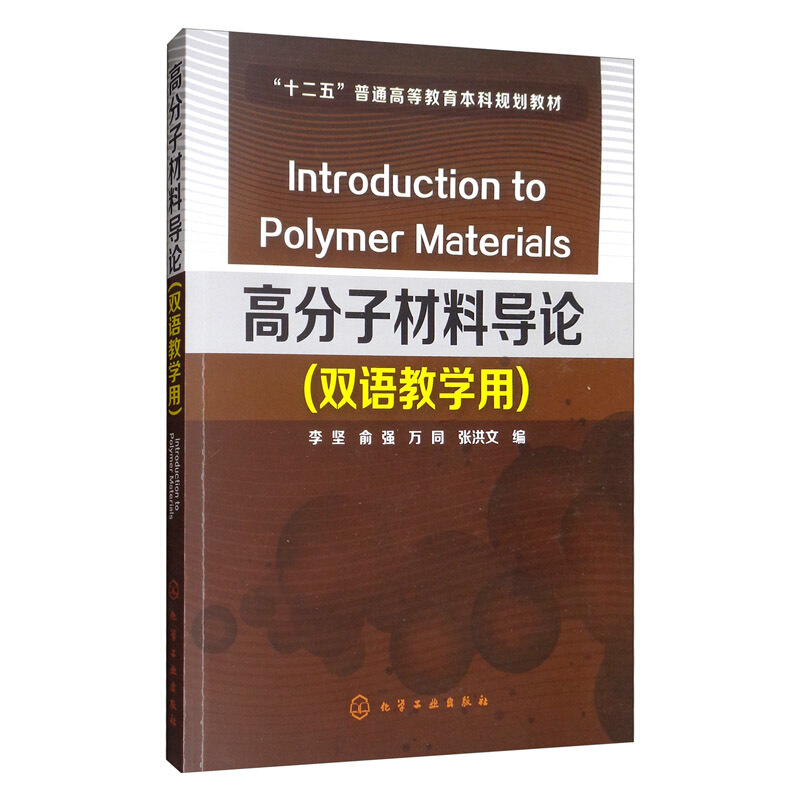- ISBN:9787122192172
- 装帧:一般胶版纸
- 册数:暂无
- 重量:暂无
- 开本:16开
- 页数:262
- 出版时间:2018-01-01
- 条形码:9787122192172 ; 978-7-122-19217-2
内容简介
本教材共10章。1. Introduction(绪论)、2. Polpmer preparation (聚合物的制备)、3. Polymer structure,molecular motion and transition (聚合物结构、分子运动和转变)、4. Polymer Properties(聚合物的性质)、5. Analysis and Testing of Polymers(聚合物表征和测试)、6. Plastics(塑料)、7.Elastimers (弹性体)、8. Polymer Composites(聚合物基复合材料)、9. Coatings (涂料)、10 Recent developments in polymer science and technology(聚合物科学技术新进展)。
目录
作者简介
李坚,常州大学材料科学与工程学院,院长 教授,合肥工业大学,本科毕业。华东化工学院(华东理工大学)硕士毕业。日本大阪大学,获博士学位。 工作及研究经历: 1988,7— 2000,12;常州大学(江苏化工学院),材料工程系工作。教学与科研。副教授。高分子教研室主任。教授的课程有:高分子化学,功能高分子,专业英语,离子交换树脂等。研究方向:水性聚氨酯,聚丙烯酸酯等粘合剂的研究;大分子过氧化物的研究。 2001,1—2001,12; 英国剑桥大学 (Melville Laboratory for Polymer Synthesis, University of Cambridge)访问学者。研究方向:聚合物发光材料的合成及性能研究(PLED);聚芴的合成。导师:Andrew B Holmes (聚合物(PPV)发光的发现者之一)。 2002,1—2007,3;日本三洋电机株式会社研究本部工作。研究方向:聚合物发光材料的合成及性能研究(PLED);有机TFT的研究;有机太阳能电池的研究;聚芴及其共聚物的合成。 2007,3--- 至今,常州大学材料科学与工程学院材料化学教研室工作。教授。教学与科研工作。主要研究方向:聚合物有机半导体的合成与性能研究;利用ATRP制备聚丙烯酸酯嵌段共聚物及其应用;涂料粘合剂的研发。 主要科研成果: 长期从事有关聚合物发光(PLED),有机TFT,有机太阳能电池及水性聚氨酯的研究。参加过多项省部级科研项目的研发工作。发表论文:在国内外杂志上发表相关论文几十篇。专利:获得美国,日本及中国有关聚合物发光材料(PLED),有机TFT及有机太阳能电池的专利共15件, 其中已公开的有 9 件。 教学工作: 长期从事教学工作,主讲了高分子化学、功能高分子材料、离子交换树脂、高分子专业外语、高分子材料导论(双语)等课程。
-

断代(八品)
¥15.5¥42.0 -

家居设计解剖书
¥29.3¥39.0 -

当代中国政府与政治(新编21世纪公共管理系列教材)
¥30.2¥48.0 -

中医基础理论
¥50.7¥59.0 -

习近平新时代中国特色社会主义思想概论
¥18.2¥26.0 -

编辑审稿实务教程
¥35.1¥45.0 -

社会学概论(第二版)
¥33.0¥55.0 -

古代汉语(第四册)
¥13.3¥35.0 -

当代教育心理学(第3版)(本科教材)
¥23.8¥66.0 -

落洼物语
¥8.4¥28.0 -

EPLAN电气设计
¥29.9¥39.8 -

软件定义网络(SDN)实战教程
¥49.6¥69.8 -
![[社版]大汉战神:霍去病传](/Content/images/nopic.jpg)
[社版]大汉战神:霍去病传
¥14.0¥40.0 -

介入护理学(案例版)
¥52.4¥69.8 -

学前教育史(第二版)
¥31.2¥48.0 -

西方经济学(宏观部分·第八版)(21世纪经济学系列教材)
¥41.7¥49.0 -

西方经济学(微观部分·第八版)(21世纪经济学系列教材)
¥17.9¥56.0 -

数理经济学的基本方法(第4版)(精)
¥56.9¥79.0 -

老子道德经注校释(精)/新编诸子集成
¥30.1¥43.0 -

科技论文规范写作与编辑(第4版)
¥63.0¥75.0












